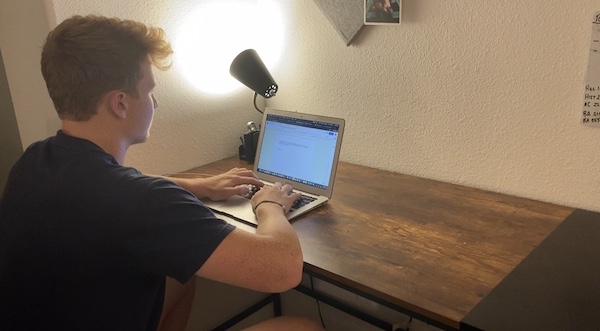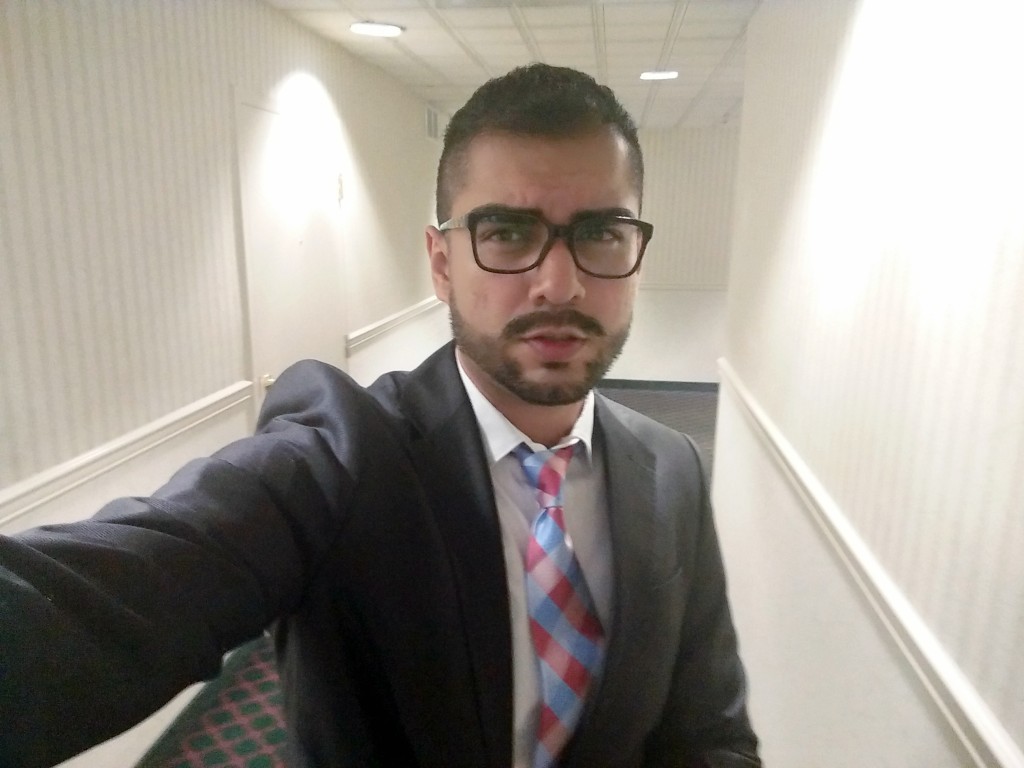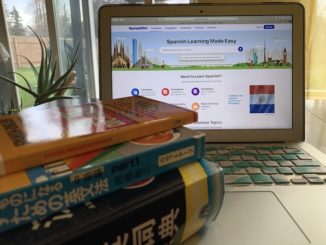
Changing times.
Changing realities.
Missed connections.
Students are now finding themselves in their bedrooms instead of classrooms, the living room instead of the quad and sitting across a screen instead of other people. As they are all taking classes online through Zoom, many are struggling to find connections with other students and ways to find a balance between school life and home life.
“It’s harder trying to collaborate via Zoom,” senior advertising major Tim Yu said. “It’s just not the same [as] seeing people person to person and getting a direct response because everything is through text or messaging platform so it’s harder to delegate whether assignments will be done on time because of different times and locations and schedules.”
Students are finding that getting to know their fellow classmates and professors is harder online and building a community within the boundaries of a screen is limiting their ability to live the college experience.
Online classes are impacting learning
Virtual classrooms have affected communication and community within students. However, there has also been an impact on their learning. Students said they have felt a decrease in focus and motivation during their online classes.
Classes that disconnect students from each other do not provide the cohesive environment that students need to connect with faculty, staff and other students, Vincent Tinto, sociology professor at Syracuse University, said at the 1999 annual conference of the National Academic Advising Association. Students need learning communities that actively involve students and faculty members in shared learning activities.
Sarah Stone Watt, divisional dean of Communication, said learning continues to take place even after classes are over. In the hallways and social spaces after classes, students continue to talk about what they learned or new ideas they have come up with, helping them to better process what they are learning and improving the overall experiencing.That’s all lost on Zoom. Students also cannot vent or get things off their chest to others or celebrate anymore as soon as class is over.
“When you’re just sitting in your room with it, it builds and you don’t have any space to just process or for something great, you don’t have people to celebrate with,” Stone Watt said. “You’re kind of limited.”
For Sophia Casetta, a sophomore international studies major, there is always a struggle for balance between her studies and home life. She noticed that because there are such blurred lines between these two, it’s difficult to find motivation for her studies.
Andrew Mimura, a freshmen computer science and math major, has also felt the struggles of going to college at home.
“There’s a big amount of distractions at home and free time so it’s harder to focus on tasks you have,” Mimura said. “I have more free time but less motivation. On campus I’d be much more motivated to learn, especially because there’s that new feeling and new experience.”
Even for a senior like Yu, the lack of motivation and attention has been an obstacle in classes.
“There’s a decrease in motivation to do work outside of class,” Yu said. “Most people I’ve talked to said they’ve had a less attention span.”
Even though there are negative outcomes to virtual classes, Communication Professor Charles Choi found a positive during this time. He said there will be technological advances that will improve how professors interact with students. During online classes, Choi has also found a new respect for the work students and professors do in classrooms.
“It’s giving me an impression that the work I do and the work we do together is more appreciative,” Choi said. “As much as possible we need to get back into classrooms.”
Communication and community in students
As online classes continue, students are facing a decrease in communication between other students and professors.
Yu said there was a decrease in communication between classmates because everybody is just trying to get through Zoom classes and only communicate in class or for group work. He felt more distant from other students and classmates because Zoom classes felt like a 9 to 5 job.
Brayden Wood, a junior sports medicine major, said it’s easy to communicate in today’s day and age with technology, but it’s harder to reach out to someone new. It’s easier to be in person and to go up to someone and introduce oneself.
“In person it’s way more convenient to turn to your left and ask a student to do something or a question or go straight to the teacher instead of having to find someone’s number and text them,’ Wood said.
Stone Watt has seen that students are having a harder time connecting with one another due to the little interaction that they have during class.
“Normally in my classes students would know each other and they would’ve met and had the chance to sort of even in class to say hey what do you want to work on or do you want to be my partner,” Stone Watt said. “And now they’re having to kind of reach out and say I think you and I might work well together based only on that little bit of interaction.”
Missing community
Mimura said it was difficult to get to know other students and took much more effort to communicate with others online.
“It’s so easy to hide and not put yourself out there when you don’t know anyone and that makes you lose interest,” Mimura said. “In person, you can chat to the person next to you. Being in class becomes much more exciting and much easier to pay attention to.”
Mimura described himself as an introvert who finds it hard to come out of his comfort zone to try to meet new students. He said if others do not reach out first, it is hard to be proactive in connecting with people and would be easier on campus to start up a conversation.
Casetta noticed the differences that she faces between online classes and on-campus classes.
“It’s nice to have a community of like minded people to talk to in your major and have a community that just gets you,” Casetta said.
Casetta said before she met the community at Pepperdine’s University Church of Christ office, she was an international business major. However, after connecting with different people at the UCC office, she realized she wanted to change her major to international studies.
People are naturally social beings who can get even more stressed when deprived of social connections during stressful times, Jonathan Kanter and Adam Kuczynski wrote in March The Conversation article.
Because students are learning at home away from other students, some feel there is a limit and boundary between each other.
Casetta said she could not form deep relationships with her fellow classmates during online summer classes.
“You’re with these people everyday, Monday through Friday, and the only way to get close is when you were forced in groups,” Casetta said. “And there was still a line or boundary because there’s a balance between school life and home life.”
Adapting to changes
Along with the students, the shift to virtual classrooms has heavily impacted the professors. Faculty members are also feeling distant from their students and are trying to find ways to connect with their students more.
Choi said he used to be more worried about content during lectures. Now he has shifted his mindset to focus on one or two elements and utilizes that time to hear student voices.
“We have that freedom and flexibility in debate and grow in intimacy with one’s peers and teachers,” Choi said.
Prior to COVID, Seaver College faculty had long rejected teaching online because of their emphasis on community and student-professor and student-to-student relationships, Choi said.
Stone Watt has seen that there is a newfound difficulty in communication between her students.
“I think I’m seeing students access office hours less which I thought it would be the other way around, and it might just be the difficulty of scheduling them when you just can’t pop in,” Stone Watt said. “So I’m trying to use the Navigate app but not everybody is on the app so certain years of students are really on it and others are not.”
Stone Watt said she is also working to help find solutions to help students build relationships with each other and with her.
“I’m trying to offer multiple options on how to schedule an office hour appointment so we can talk about things,” Stone Watt said. “I’m having them do some assignments outside of class where they are collaborating in different document forms so they’re seeing each other’s written work a little bit more than they would normally would, which I think is helping.”
Choi also adopted a new way to start class that mimics an in-person class. He said he starts class by having a “soft start” where the first 10 minutes of class is dedicated for students to interact with each other in random breakout rooms.
Mimura also tried to lessen the emotional distance by being in group messaging chats and study sessions.
“For my major classes, some of them made a Discord that was really helpful making it easier to reach out because it’s a big group chat and I can make more friends,” Mimura said.
Yu said he felt better when studying and interacting with other students through Zoom study sessions.
“Studying alone staring at your bedroom doesn’t help and being at home sucks and I don’t feel alone on study sessions and don’t feel trapped,” Yu said.
Wood has been trying to safely build a community with other students by doing outdoor activities like surfing and hiking. He said he felt that there was an importance in having a change of scenery and being with other people during this time.
“It’s good for my mental health to get outside of my house and be outdoors and interact with different people,” Wood said.
As students and professors are adapting to the new changes of online learning, they are finding out what works and what doesn’t work. Many are realizing that building communication and finding a community is the hardest part of virtual classes.
“It’s that social aspect that’s part of the learning process that is definitely super different in this format,” Stone Watt said. “FInd some ways, safely, to get that human interaction that you need.”
Heidi Han completed the reporting for this story under the supervision of Dr. Christina Littlefield and Dr. Elizabeth Smith in Jour 241 in Fall 2020. Dr. Littlefield supervised the web story.



